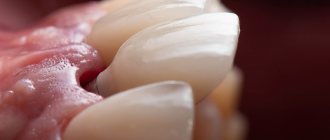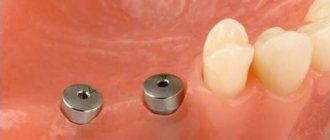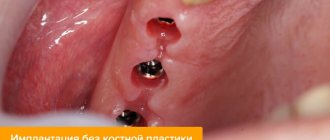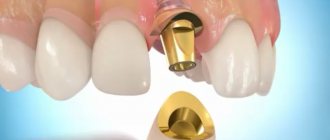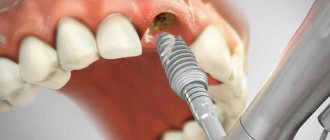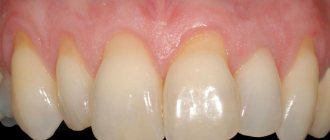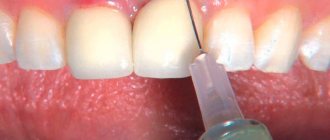Dental implantation is a complex procedure that requires intervention in the soft tissues of the oral cavity. To avoid all sorts of complications, it is very important to follow the dentist’s recommendations. Swelling and redness may be observed for several days after surgery, which is considered normal. If other unpleasant symptoms appear, you should consult a specialist to prevent rejection of the prosthesis and other pathological conditions.
Functions of the gums during implantation
The purpose of implantation is to restore not only the chewing, but also the aesthetic functions of the dentition. This problem can be solved only by having a sufficient volume of bone tissue (to hold the implant, distribute the chewing load) and healthy mucous membrane (to protect the bone, provide access to nutrients, and protect the implantation area from infection).
Therefore, the gum around the implant must have the desired histological structure and in sufficient volume to provide:
- Aesthetics Recreate a gingival contour that does not differ from the area of neighboring teeth.
- Functionality Provide nutrition to the bone around the implant, as well as support for the crown or prosthesis.
- Prevention of rejection Protect the implant from plaque and bacteria, reduce the risk of peri-implantitis.
BozhkovRoman Andreevich
Implant surgeon, 13 years of experience
Nobel Biocare Certified Specialist
Leading specialist in bone reconstruction and ultrasonic sinus lifting, high-complexity gum surgery
More about the doctor
The gum former fell out: what to do?
It is also possible that the former becomes unscrewed and falls out of the implant. This may occur due to a loose fit of the element to the titanium root. This happens when the surgeon secured the implant too deep into the bone, and bone tissue grew on it, making it impossible to secure the former tightly. To correct this deficiency, you need to visit a doctor. When the gum former has already fallen out, the first thing you should do is carefully screw it into place and make an appointment with the dentist. Without a plug for a long time, the hole may become overgrown.
When is soft tissue augmentation necessary?
An operation to replenish gum volume is performed when there is a deficiency of gum, which can arise due to a number of factors.
Initial gingival deficiency
To achieve good aesthetics, the thickness of the gum tissue must be at least 5 mm. But such ideal conditions are extremely rare for reasons:
- Long-term absence of a tooth - without chewing loads, the bone atrophies, the gums also shrink and decrease
- Wearing removable dentures or adhesive bridges - mechanical pressure leads to soft tissue loss
- Thin mucosal biotype is a physiological feature of the body in which the gum thickness is only 2-3 mm
In such cases, there is a high risk of the formation of an unaesthetic gingival contour and the absence of gingival papillae around the implant.
Even when planning treatment, our specialists analyze the volume and condition of the gums in order to, in case of deficiency, provide for surgery to build up soft tissue at one of the stages of treatment.
Errors during implantation
Loss of gum volume is also possible during implantation if the operating surgeon does not know how to work correctly with mucous tissues. Common mistakes made by novice doctors:
- Excessive, thoughtless mechanical damage to gingival tissue at one of the stages of the operation
- Excessive tension when suturing - healing occurs with pronounced defects
Not only the surgeon, but also the orthopedist must understand the importance of maintaining the volume and quality of soft tissue. Temporary structures during the healing stage should not interfere with the regeneration process. Incorrect placement and pressure of the temporary prosthesis on the mucous membranes leads to their slow growth and trauma.
If the operation and prosthetics were carried out negligently, plastic surgery on the gums after implantation cannot be avoided in 99% of cases.
Therefore, we recommend that you carefully choose a clinic and doctors. Exposure of the implant
The formed gum around the implant (as well as around the teeth) is of two types:
- Attached - motionless, tightly fused with the periosteum
- Movable - moves when lips and cheeks move
If there is a lack of attached gum or the patient does not comply with the rules of care (aggressive brushing of teeth or, conversely, lack of oral hygiene), the implant neck is gradually exposed - soft tissues are torn off, the gums recede, and periodontal pockets are formed.
To prevent such situations, it is necessary to replenish the gum volume even before implantation and follow the doctor’s recommendations during the recovery period. If the moment was missed and the implant was exposed, gingivoplasty is performed, but in such cases a number of procedures are first performed to eliminate inflammation.
If you ignore the problem, inflammatory processes can spread to surrounding tissues and provoke serious complications:
- Mucositis - inflammation of the soft tissue around the artificial root without involving bone structures
- Peri-implantitis is a more severe condition where bone tissue detaches from the implant.
In our Center, implantation is performed by experienced implantologists and maxillofacial surgeons who are fluent not only in implantation protocols, but also in various techniques for carefully working with soft tissues. We do not strive to quickly “screw in” implants at any cost. Our task is to take care of the condition of the mucous tissues, since the success of implantation depends on this, which we carry out in the format of a lifetime guarantee.
Possible complications
In most cases, swelling, discomfort, and pain disappear 5-7 days after implantation. If after this time the symptoms do not disappear or increase, you should consult a specialist to rule out the following pathologies:
- hyperplasia. Rapid proliferation of mucous membranes at the implantation site. Elimination will require partial removal of mucous tissue;
- fistulas, purulent foci. A characteristic sign of such consequences may be white dotted plaque on the gums. Inflammation can result from infection during surgery, medical negligence, injury to the nasal sinuses, incorrect choice of implant, poor oral hygiene, and bad habits;
- peri-implantitis. Beginning of prosthesis rejection. Bleeding, severe swelling, redness, pain, and numbness may indicate pathology. In this case, immediate treatment and curettage are required;
- implant rejection. It is rarely recorded in dental practice. Characterized by the mobility of the installed rod. The cause of the violation may be physiological characteristics, doctor errors, chronic diseases in the acute phase, poor hygiene, and bad habits.
To minimize the risk of such conditions, you should follow your doctor's postoperative recommendations.
At what stage of implantation is gum plastic performed?
Depending on the causes of the gum deficiency and the period of manifestation of the defect, the procedure is performed during one of the stages:
- Before or simultaneously with implantation In case of initial gum deficiency or thin biotype, operations are best performed before implantation. But if the implantologist is skilled in perioplasty, the procedure is also possible during implant installation.
- After implantation before prosthetics This stage is often chosen after osseointegration of the implant - during its opening in preparation for the installation of an orthopedic structure. At this stage, errors after implantation are corrected through gingivoplasty and the immediate installation of a gum former.
- In the delayed period of operation This is carried out if the parameters of the mucous membranes were not taken into account in the early stages, and over time the implant neck became exposed. It is recommended to carry out the procedure as soon as possible to reduce the risk of bone inflammation and prevent rejection of the artificial root.
Gumplasty is a necessary solution for successful implantation
By replenishing the missing volume of soft tissue, the aesthetic gum contour is recreated, and the risk of infection of bone tissue and implant rejection is reduced.
Levin Dmitry Valerievich Chief physician and founder of the Doctor Levin center
In what specific cases is gingivoplasty needed?
When preparing for implantation, the following indications for gum augmentation may be identified:
- Loss of soft tissue caused by bone resorption in the area of a long-term missing tooth.
- Severe gum detachment resulting from periodontitis.
- Defects in the mucous membranes resulting from trauma to this area.
A sufficient volume of soft tissue during implantation is very important. It helps not only to qualitatively install an artificial root, but also to form an aesthetic gingival cuff around it. In addition, if the mucous membranes are in good condition, this contributes to normal nutrition of the bone structures. An implant that is tightly covered by the gum holds in the socket more firmly and is better protected from the penetration of bacteria. Therefore, the dental surgeon always investigates at the preparatory stage whether gum augmentation is necessary for implantation. And if such a need is identified, gingivoplasty is planned.
Operation stages
The operation in the area of one implant lasts 30-60 minutes. Absolutely painless, because... performed under local anesthesia. For patients with fears, it is possible to perform the operation “in their sleep”.
- Anesthesia Infiltration or conduction anesthesia is used. If desired by the patient or according to indications, sedation (controlled sleep).
- Plastic Depending on the clinical picture, local tissues are used to form the gums, a flap of the required size or matrix is applied.
- Suturing is carried out under the control of a dental microscope, using the finest threads. Neat sutures without displacement or tissue tension improve healing.
Gum extension techniques
There are two main methods of gingivoplasty:
- flap plastic surgery – tissue from the patient’s oral cavity is used. The doctor incises a section of the gum and, using a tissue flap from other areas of the mucous membrane (adjacent gum, palate, inner part of the cheek), forms a contour,
- extension with collagen matrices or barrier membranes - the material is tightly sewn to the area of the gum that needs to be restored, and then the body forms its own tissues based on the material.
Why is it better in sedation
Sedation
